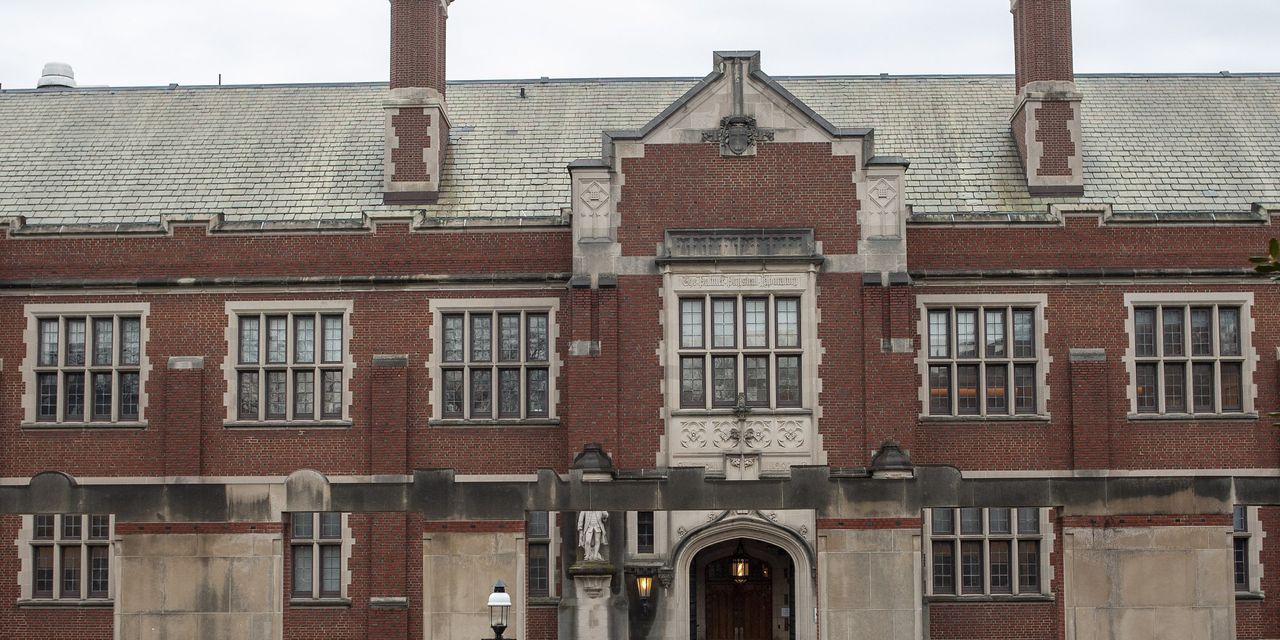A year of changes and hand-wringing over methodology didn’t do much to change the results of the U.S. News undergraduate college rankings, which the publication released Monday.
Princeton ranked number one as it has for the past 13 years and the other schools rounding out the top spots included the same Ivy League and other highly selective colleges. Despite their predictability, controversy surrounding them and evidence that they’re not crucial to students’ decision making, the U.S. News rankings remain a fixation in higher education circles.
Just one example: At a recent convening of college presidents and media, leaders kept returning to their grievances surrounding rankings when asked about other topics.
So why do they remain influential when school and federal officials deride them and students have a variety of sources of information about colleges at their disposal? Likely a drive for an elusive marker of prestige among wealthier applicants whose families are influential in the discourse surrounding college and the schools who serve them, experts say.
“So many academically and frankly economically privileged applicants are raised to value status and social status and prestige and high incomes and things like that,” said Colin Diver, the author of Breaking Ranks: How the Rankings Industry Rules Higher Education and What to Do about It. “They’re eager to know what schools have the most prestige, what schools will confer the most status.”
“The rankings, particularly U.S. News, are the most prominent measures of institutional status in higher education,” said Diver, who served as the president of Reed College, which pulled out of the U.S. News rankings in 1995. “They’re influential for that reason.”
Rankings can also fill an information void for students and families, serving as a “shortcut” way to categorize the thousands of institutions across the country, said David Hawkins, the chief education and policy officer at the National Association of College Admission Counseling.
“The rankings tend to pass themselves off as authoritative, quantitatively based measures of college quality and therefore convey some sheen of objectivity,” he said. Still, what those who follow the space closely know, he said, is that depending on what factors are emphasized different colleges can move towards the top, he said. “You can almost look at any college and see some sort of designation.”
Despite college leaders’ criticism that the rankings create a one-size-fits-all way to evaluate schools that masks the vast differences between them, “they are aware that these rankings can provide them with some marketing gold,” Hawkins said. As such, some schools may complain, but they’ll still tout their ranking when they do well.
Put another way, rankings are something that “admissions officers love to hate and hate to love,” he said.
Eric Gertler, the CEO of U.S. News, has argued that the publication keeps schools accountable for the education they deliver. “Our goal is to provide prospective students and families with the information they need to make a decision about the college they will attend,” Eric Brooks, principal data analyst for education U.S. News, wrote in an email.
Once filled an information void for families
When U.S. News first began ranking schools in 1983, it did indeed fill a void in some ways. A wide swath of authoritative data on colleges wasn’t easily accessible. Students and families might flip through the U.S. News booklet in their homes or at the guidance counselor’s office to get a sense of their universe of school options.
But in the intervening years, the U.S. News rankings have become entrenched in higher education and critics say they’ve skewed college leaders’ incentives to emphasize factors that don’t always benefit students.
“They take other types of information that students bring with them to the college to somehow attribute that quality to the college,” Hawkins said, like standardized test scores and class rank. This year, U.S. News dropped high school class rank from its methodology and said that roughly 50% of its criteria is focused on a college’s outcomes, as opposed to inputs.
The rankings and colleges’ fixation with them may also literally be costing students and families, some college leaders say. “It certainly in my mind has contributed directly to the rise in tuition because there’s no incentive for keeping tuition down, in fact it rewards spending per student,” Michael Elliott, the president of Amherst College, said at a gathering of college presidents and media.
And indeed, financial resources per student account for about 8% of the weight in the U.S. News methodology, more than average federal student loan debt (5%), and slightly less than the weight given to outcomes for first-generation and low-income students (11%).
Continuing to include factors like standardized test scores in the methodology (5% weight for schools with usable scores) can create “perverse incentives like buying students,” said L. Song Richardson, the president of Colorado College.
Students with access to resources like standardized test preparation courses, tend to score better on these tests. To lure them into attending in part to boost a college’s rankings, some schools will provide so-called merit aid.
“When schools have limited funds and you’re spending your funds to get students that have high metrics, you often don’t have sufficient funds left for need-based aid,” Richardson said. “It creates these perverse incentives at a time when everyone is talking about how expensive higher education is.”
In the past, when the rankings emphasized selectivity, schools would spend money on marketing in order to increase the number of applications they received so they could reject a larger share of them, she said. Now, schools still spend money to send materials or branded goodies to officials at other schools who participate in broad college surveys to influence how they rank, according to Richardson. A peer assessment, which Song described as a “beauty contest,” accounts for 20% of a school’s ranking — more than any other single factor.
These were some of the reasons why Richardson announced earlier this year that she would pull her school out of the rankings. Colorado College came in at No. 29 in the liberal arts rankings that were just released, down two spots from last year. She’d viewed the rankings as “illegitimate” for years, both as a law school dean and at Colorado College.
Once high profile law schools, including Yale and Harvard, and medical schools started pulling out of the professional school rankings last year and early this year, Richardson took advantage of the momentum — and the fact that Colorado College didn’t pay too much attention to the rankings anyway — and withdrew, she said.
Undergraduate colleges haven’t abandoned the rankings in the same way professional schools have, at least not yet. Richardson said she hopes more undergraduate colleges will join her. “If schools are going to do it I feel like now is the time,” she said.
‘Low validity, high impact’
For David Harris, the president at Union College, continuing to participate in the rankings made sense, despite his misgivings about them. Even if his school decided not to participate, they would still be ranked since U.S. News and other rankings are pulling much of their data from publicly available sources, he said.
Harris compared asking and answering the question of what’s the best college to asking the resident of a city to name the town’s best restaurant. What comes out as the best, changes depending on the criteria of the person evaluating, he noted. For example, are they a vegan? Do they value a good wine list?
In that way, “the rankings are inconsistent with at least the message I’ve given my own kids,” he said, which is to look for the school that’s the best fit for them, he said.
Still, he knows certain constituencies pay close attention to the lists. “When the rankings come out, there are some alums who every year, it tells the value of their degree like checking their stock ticker,” he said.
Throughout his career in higher education, which have included leadership roles at Tufts University and Cornell University, Harris said his take on rankings has been “these are low validity high impact.”
U.S. News did make changes to its methodology this year in response to some of the concerns expressed by college leaders and higher education stakeholders more broadly. In addition to dropping class rank, the publication’s methodology no longer considers alumni giving, class size, faculty with terminal degrees and the share of graduates who take on federal loans.
The publication said the changes mean that more than 50% of the weight of a school’s rank is focused on how a college boosts its students, not what students bring with them to the school. That comes after a proliferation in recent years of rankings focused on social mobility and other outcomes.
Inputs vs. outcomes
Baruch College, which is part of the City University of New York, consistently shines in these measures. For example, in a New York Times ranking that combines high earnings with low price, Baruch comes in at No. 4 behind Princeton University, Massachusetts Institute of Technology and Stanford University. In a Wall Street Journal ranking focused on social mobility, Baruch comes in at No. 7. (The Wall Street Journal and MarketWatch share a parent company, Dow Jones).
In the U.S. News list, which ranks Baruch as a regional university in the north, the school came in at No. 9, up five spots from last year.
“We certainly welcome the trend where a lot more rankings are now focusing on the outcome rather than the input,” said S. David Wu, the president of Baruch College. “We believe that education is about transforming students from where they are to who they can be,” he said.
The school leans on a strong alumni network in New York City to help students land jobs at well-known firms. In addition, Baruch is able to attract top professors who prepare students for successful careers thanks to its reputation and location, Wu said. Baruch also works to offer wrap-around services to students that provide them with resources to get through school and on to a decent paying job.
The school’s graduation rate is well above the national average, even as roughly 60% of students who attend the school receive a Pell grant, the money the government provides to low-income students to attend college. “That combination is not the norm,” Wu said.
Wu believes that rankings methodologies are starting to reflect what students and families are increasingly concerned about — whether their financial investment is actually providing them with something, not necessarily a school’s reputation.
Colleges’ pushback to being ranked is nothing new and it will likely continue even if U.S. News loses its relevance. When the federal government proposed using its data to rate schools in 2013, it made them “very uncomfortable,” said Michael Itzkowitz, the president of the HEA Group, a policy and research organization.
At the time, Itzkowitz was focused on building out the College Scorecard, a public-facing government database with granular data on individual institutions. “We had about 170 meetings with advocacy groups and stakeholders to hear about their concerns with rating institutions,” said Itzkowitz, the former director of the College Scorecard.
Ultimately, the government decided not to rate schools. But the proliferation of data has allowed researchers and publications to evaluate colleges in a variety of ways.
Despite the controversy around ranking schools, the lists will still likely influence college leaders’ decision making even as they look for ways to serve a wide swath of students following the Supreme Court’s decision to ban affirmative action, Hawkins said.
“The realist in me suggests that this will continue to be a major bone of contention as presidents, admissions officers, deans, faculty and others grapple with how we respond to the Supreme Court and how institutions strive towards more equity,” he said. “Any change that institutions will make to their processes will probably at some point raise that question, what will this do broadly to our institutional ranking? The rankings are that integrated into the institutions’ thinking at this point that really any change they make might broach that question.”
Read the full article here













Leave a Reply